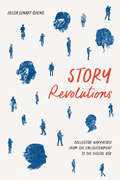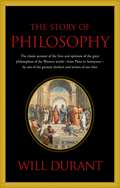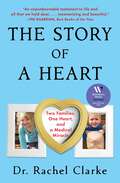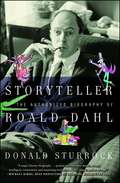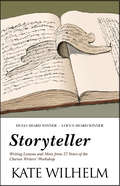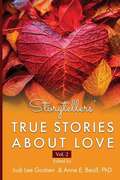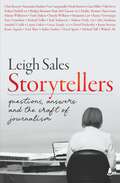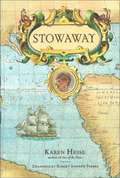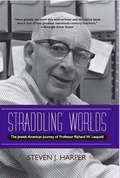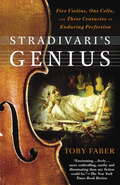- Table View
- List View
Stormtrooper on the Eastern Front: Fighting with Hitler's Latvian SS
by Mintauts BlosfeldsThe memoir of a reluctant soldier coerced into military service by the Nazis and driven from his homeland by the Russians. Following the conquest of his native Latvia by the Nazis, Mintauts Blosfelds was given the stark choice: service in the SS or forced labor in a slave camp. So he &“volunteered&” to fight for the Nazis. In this memoir he describes his training and how he became an instructor before being sent into Russia. He nearly perished during the terrible winter of 1943–44 after being wounded and finding himself with his friend lying dead on top of him. As the tide turned, the Russians advanced remorselessly through. He would be wounded twice more and awarded the Iron Cross for bravery. With German resistance collapsing, he had to flee for his life—capture by the Russians meant almost certain death. He surrendered to the Americans, but describes the neglect he suffered at their hands. Unable to return to Latvia, which was now occupied by the Russians, he became a Displaced Person, eventually settling in the UK. This book tells his compelling story.
Stormy Weather
by James GavinTHE "DEFINITIVE" (VANITY FAIR ) BIOGRAPHY OF LEGEND LENA HORNE--THE CELEBRATED STAR OF STAGE, MUSIC, AND FILM WHO BLAZED A TRAIL FOR AFRICAN AMERICANS IN HOLLYWOOD AND BEYONDDrawing on a wealth of unmined material and hundreds of interviews-- one of them with Lena Horne herself--critically acclaimed author James Gavin gives us a "deftly researched" (The Boston Globe) and authoritative portrait of the American icon. Horne broke down racial barriers in the entertainment industry in the 1940s and '50s even as she was limited mostly to guest singing appearances in splashy Hollywood musicals. Incorporating insights from the likes of Ruby Dee, Tony Bennett, Diahann Carroll, and Bobby Short, Stormy Weather reveals the many faces of this luminous, complex, strong-willed, passionate, even tragic woman--a stunning talent who inspired such giants as Barbra Streisand, Eartha Kitt, and Aretha Franklin.Cotton Club, Stormy Weather offers a fascinating portrait of a complex, even tragic Horne -- a stunning talent who inspired such giants of showbiz as Barbra Streisand, Eartha Kitt, and Aretha Franklin, but whose frustrations with racism, and with tumultuous, root-less childhood, left wounds too deep to heal. The woman who emerged was as angry as she was luminous. From the Cotton Club's glory days and the back lots of Hollywood's biggest studios to the glitzy but bigoted hotels of Las Vegas's heyday, this behind-the-scenes look at an American icon is as much a story of the limits of the American dream as it is a masterful, ground-breaking biography.
Story Revolutions: Collective Narratives from the Enlightenment to the Digital Age (Cultural Frames, Framing Culture)
by Helga Lenart-ChengSocial media has facilitated the sharing of once isolated testimonies to an extent and with an ease never before possible. The #MeToo movement provides a prime example of how such pooling of individual stories, in large enough numbers, can fuel political movements, fortify a sense of solidarity and community, and compel public reckoning by bringing important issues into mainstream consciousness.In this timely and important study, Helga Lenart-Cheng has uncovered the antecedents of this phenomenon and provided a historical and critical analysis of this seemingly new but in fact deeply rooted tradition. Story Revolutions features a rich variety of case studies, from eighteenth-century memoir collections to contemporary Web 2.0 databases, including memoir contests, digital story-maps, crowd-sourced Covid diaries, and AI-assisted life writing. It spans the Enlightenment, the 1930s, and the twenty-first century—three historical periods marked by a convergence of mass movements and new methods of data collection that led to a boom in activism based in the aggregation and communication of stories. Ultimately, this book offers readers a critical perspective on the concept of community itself, with incisive reflections on what it means to use storytelling to build democracy in the twenty-first century.
Story of My Life: An Afghan Girl on the Other Side of the Sky
by Tamim Ansary Farah Ahmedi"I was late to school, and that's all I could think about. I started across the field. And then suddenly a fire flashed in my face and the earth seemed to move beneath my feet. I remember a shower of soil and then nothing. I woke up on the ground, surrounded by a crowd, men and boys...no women. They were all staring down at me with huge eyes. Their lips were moving, but I could hear no voices. All I heard was a loud ringing in my ears." <P><P> Farah Ahmedi is born into the world just as the war between the mujahideen and the Soviets reaches its peak in Afghanistan. Bombs are falling all over her country, and her native Kabul is swelling with hundreds of thousands of people looking for homes and jobs. The sounds of gunfire and fighter planes are as normal to Farah as the sounds of traffic or children playing are to a schoolgirl in America. When Farah steps on a land mine on her way to school, her world becomes much smaller than the dreams and hopes in her heart. She begins to learn--slowly--that ordinary people, often strangers, have immense power to save lives and restore hope. <P> The Story of My Life: An Afghan Girl on the Other Side of the Sky recounts an epic journey. It deftly interweaves a childhood in Afghanistan, where the classrooms are naked chambers with only chalkboards on the walls and are filled with more students than seats (and no books), with an American adolescence, where teenagers struggle to decide whether to try out for school plays, whom to take to the homecoming dance, and where to go to college. In Kabul, they cancel school because of rockets and bombings; in Chicago, Farah might have a snow day. In Kabul, a schoolgirl wears a black dress and a white headscarf; in America, girls need the right jeans and trendy tops. <P> Thanks to a number of good people who crossed her path at critical moments, Farah is thriving. She may be haunted by her past, but she is no longer enslaved by it. She is actively enjoying the realization of her childhood dreams; she's an Afghan American, free to learn, work, support herself, and choose her own path. She'll graduate from high school soon and is being recruited by some of the best colleges in the world. Farah is living proof that not only can the human heart endure, it can also thrive. Even in war, there are miracles. Even when limbs are amputated, we are whole. Even in refugee camps, dreams come true. Even when fathers and siblings die young, there is love. The Story of My Life is our new great American memoir.
Story of Philosophy: The Lives And Opinions Of The Great Philosophers
by Will DurantA brilliant and concise account of the lives and ideas of the great philosophers -- Plato, Aristotle, Bacon, Spinoza, Voltaire, Kant, Schopenhauer, Spencer, Nietzsche, Bergson, Croce, Russell, Santayana, James and Dewey -- The Story of Philosophy is one of the great books of our time. Few write for the nonspecialist as well as Will Durant, and this book is a splendid example of his eminently readable scholarship. Durant's insight and wit never cease to dazzle; The Story of Philosophy is a key book for any reader who wishes to survey the history and development of philosophical ideas in the Western world.yle. The Story of Philosophy opens vistas of intellectual adventure and growth to those who hunger for the total perspective that is philosophy. Within its pages, Durant seeks the wisest and most indestructible answers from the world's greatest philosophers to the persistent and fundamental questions about first and last things.
Story of Your Mother
by Chantal BraganzaWhat if we considered motherhood an organizing principle instead of a genre or subject?In her debut book of essays, Chantal Braganza considers the limits of understanding motherhood as identity or action alone, while reflecting on her upbringing as a daughter of Mexican and Indian immigrants and the first years of raising her two children. Inspired by the thinking of Dionne Brand, Maggie Nelson and Jacqueline Rose, she explores what shapes the things we reach for as we search for our family's place in the world. How do we tell our children who they are when we're still struggling to find that language to describe ourselves?Braganza weaves dreamlike memoir sections of her childhood—some memories, some myths passed down from her family in Vallarta, Mombasa, London, and Toronto—with urgent essays about migration, identity, and speech. She wrangles with the limits of language—finding that even fluency doesn't guarantee the ability to translate something for your children. She engages with the physicality of motherhood and loss, nourishment and violence. The questions that emerge are: Can we believe the people who have given us the story of who we are? And how do we craft that story for our own children?
Story of a Heart: Two Families, One Heart, and the Medical Miracle that Saved a Child's Life
by Rachel ClarkeA riveting and inspiring true story of two families linked by one heart—written by a bestselling author and palliative care doctor. The first of our organs to form and the last to die, the heart is both a simple pump and the symbol of what makes us human; as long as it continues to beat, there is hope. In The Story of a Heart, Dr. Rachel Clarke interweaves the history of medical innovations behind transplant surgery with the story of two children—one of whom desperately needs a new heart. One summer day, nine-year-old Keira Ball was in a terrible car accident and suffered catastrophic brain injuries. As the rest of her body began to shut down, her heart continued to beat. In an act of extraordinary generosity, Keira&’s parents and siblings immediately agreed that she would have wanted to be an organ donor. Meanwhile nine-year-old Max Johnson had been in a hospital for nearly a year, valiantly fighting the virus that was causing his young heart to fail. When Max&’s parents received the call they had been hoping for, they knew it came at a terrible cost to another family—in what Clarke calls &“the brutal arithmetic of transplant surgery.&” The act of Keira&’s heart resuming its rhythm inside Max&’s body was a medical miracle. But this was only part of the story. While waiting on the transplant list, Max had become the hopeful face of a campaign to change the UK&’s laws around organ donation. Following his successful surgery, Keira&’s mother saw the little boy beaming on the front page of the newspaper and knew it was the same boy whose parents had recently sent her an anonymous letter overflowing with gratitude for her daughter&’s heart. The two mothers began to exchange messages and eventually decided to meet. This is the unforgettable story of how one family&’s grief transformed into a lifesaving gift. Clarke relates the urgent journey of Keira&’s heart and explores the history of the remarkable surgery that made it possible, stretching back over a century and involving the knowledge and dedication not just of surgeons but of countless nurses and technicians, immunologists and paramedics. The Story of a Heart is a testament to compassion for the dying, the many ways we honor our loved ones, and the tenacity of love.
Story of a Shipwrecked Sailor
by Gabriel García Márquez Randolf HoganAVAILABLE FOR THE FIRST TIME IN eBOOK!In 1955, Garcia Marquez was working for El Espectador, a newspaper in Bogota, when in February of that year eight crew members of the Caldas, a Colombian destroyer, were washed overboard and disappeared. Ten days later one of them turned up, barely alive, on a deserted beach in northern Colombia. This book, which originally appeared as a series of newspaper articles, is Garcia Marquez's account of that sailor's ordeal. Translated by Randolf Hogan.
Story of a Soul: The Autobiography of St. Therese of Lisieux
by St. Therese of Lisieux John ClarkeThis is a religious classic, the autobiography of perhaps the greatest of our modern saints and one whose "littleway" may be imitated by anyone.
Story: The Way of Water
by Anne E. LenehanStory Musgrave has an insatiable passion for life. From his childhood on a dairy farm in western Massachusetts, to payload commander on the Hubble Space Telescope rescue mission, share Story’s incredible physical and spiritual journey as he relates to the world, and the universe, around him. Based on a thematic biographical style, this intimate portrait of one of the world’s greatest thinkers, explorers and aviators is revealed through the eyes of Story himself, his family, friends and colleagues. Story is an American hero, renaissance man and, arguably, NASA’s greatest unofficial spokesperson - certainly one of the few with real vision and authenticity. This book has wide appeal to a variety of audiences. It is a human journey which happens to take place largely within the framework of the space program, but also encompasses themes such as mechanics, flying, nature, spirituality and humanity.
Storyteller: The Authorized Biography of Roald Dahl
by Donald SturrockTHE FIRST AUTHORIZED BIOGRAPHY OF ROALD DAHL, STORYTELLER IS A MASTERFUL, WITTY AND INCISIVE LOOK AT ONE OF THE GREATEST AUTHORS AND ECCENTRIC CHARACTERS OF THE MODERN AGE. In his lifetime Roald Dahl pushed children's literature into uncharted territory, and today his popularity around the globe continues to grow, with millions of his books sold every year. But the man behind the mesmerizing stories has remained largely an enigma. A single-minded adventurer and an eternal child who gave us the iconic Willy Wonka and Matilda Wormwood, Dahl was better known during his lifetime for his blunt opinions on taboo subjects--he was called an anti-Semite, a racist and a misogynist--than for his creative genius. His wild imagination, dark humor and linguistic elegance were less than fully appreciated by critics and readers alike until after his death. Granted unprecedented access to the Dahl estate's extraordinary archives--personal correspondence, journals and interviews with family members and famous friends--Donald Sturrock draws on a wealth of previously unpublished materials that informed Dahl's writing and his life. It was a life filled with incident, drama and adventure: from his harrowing experiences as an RAF fighter pilot and his work in wartime intelligence, to his many romances and turbulent marriage to the actress Patricia Neal, to the mental anguish caused by the death of his young daughter Olivia. Tracing a brilliant yet tempestuous ascent toward notoriety, Sturrock sheds new light on Dahl's need for controversy, his abrasive manner and his fascination for the gruesome and the macabre. A remarkable biography of one of the world's most exceptional writers, Storyteller is an intimate portrait of an intensely private man hindered by physical pain and haunted by family tragedy, and a timely reexamination of Dahl's long and complex literary career.
Storyteller: The Life of Robert Louis Stevenson
by Leo DamroschFrom a critically acclaimed biographer, an engrossing narrative of Robert Louis Stevenson&’s life, a story as romantic and adventurous as his fiction&“Damrosch brings to Stevenson&’s life the calm, humane interpretive powers that he deployed with such success in . . . The Club. . . . [An] excellent book.&”—Meghan Cox Gurdon, Wall Street Journal &“This magnificent biography of Robert Louis Stevenson reveals much about a writer that we think we knew. . . . Dazzling.&”—Kirkus Reviews (starred review) Robert Louis Stevenson (1850–1894) is famed for Treasure Island, Kidnapped, and Strange Case of Dr. Jekyll and Mr. Hyde, but he published many other novels and stories before his death at forty-four. Despite lifelong ill health, he had immense vitality; Mark Twain said his eyes burned with &“smoldering rich fire.&” Born in Edinburgh to a family of lighthouse engineers, Stevenson set many stories in Scotland but sought travel and adventure in a life as romantic as his novels. &“I loved a ship,&” he wrote, &“as a man loves burgundy or daybreak.&” The adventures were shared with his free-spirited American wife, Fanny, with whom he moved to the South Pacific. Samoan friends named Stevenson &“Storyteller.&” Reading, he said, &“should be absorbing and voluptuous; we should gloat over a book, be rapt clean out of ourselves.&” His own books have been translated into dozens of languages. Jorge Luis Borges called his stories &“one of the forms of happiness,&” and other modernist masters as various as Proust, Nabokov, and Calvino have paid tribute to his greatness as a literary artist. In Storyteller, Leo Damrosch brings to life an unforgettable personality, illuminated by many who knew Stevenson well and drawing from thousands of the writer&’s letters in his many voices and moods—playful, imaginative, at times tragic.
Storyteller: Writing Lessons and More from 27 Years of the Clarion Writers' Workshop
by Kate Wilhelm"Wilhelm really knows students and knows how to teach them to craft a professional story. "--The Oregonian Part memoir, part writing manual, Storyteller is an affectionate account of how the Clarion Writers' Workshop began, what Kate Wilhelm learned, and how she passed a love of the written word on to generations of writers. Includes writing exercises and advice. A Hugo and Locus award winner.
Storytellers' True Stories About Love
by Anne E. Beall Judi Lee GoshenIn this second collection, the editors gather thirty more personal stories around the theme of love in all its permutations. in "The Verb to Mother," Mary Dean Cason faces disparagement from a stranger because her child is adopted. In "A Deaf Heart," Dwayne A. Harris learn Sign to support his Deaf brother and his friends. In "That Time We Didn't Die in a Grill Fire," Jaclyn Hamer tells the hilarious story of a near-disaster that helped her family heal after her mother's death. In "Hand, Foot, Hand," Deborah Kent, who is blind, recalls a perilous childhood adventure with her younger brother.
Storytellers: Questions, Answers and the Craft of Journalism
by Leigh SalesHighly respected ABC anchor, bestselling author and hit podcaster Leigh Sales interviews the cream of Australian journalists about their craft – how (and why) they bring us the stories that inform our lives. Leigh Sales is one of Australia&’s most accomplished journalists, having anchored the ABC&’s flagship 7.30 program for twelve years. She has been a foreign correspondent, hosted Lateline and anchored numerous elections for the ABC. In this book, she turns her interviewing skills onto her own profession, those usually asking the questions: the journalists. In ten sections – from News Reporting to Editing, via Investigative, Commentary and of course Interviewing – Sales takes us on a tour of the profession, letting the leaders in their field talk direct to us about how they get their leads, survive in war zones, write a profile, tell a story with pictures, and keep the show on the road. A who&’s-who of Australian journalism – including Lisa Millar, Kate McClymont, Hedley Thomas, Trent Dalton, Benjamin Law, Tracy Grimshaw, Richard Fidler, David Speers, Stan Grant, Niki Savva, Waleed Aly, Annabel Crabb, Karl Stefanovic and Mia Freedman – talk candidly about their greatest lessons and their trade secrets. A fascinating insight into a vital and much-misunderstood profession, Storytellers is a book for anyone who&’s ever wanted to be a journalist, or even just wondered how the news gets made.
Storytelling Apes: Primatology Narratives Past and Future (Animalibus)
by Mary Sanders PollockThe annals of field primatology are filled with stories about charismatic animals native to some of the most challenging and remote areas on earth. There are, for example, the chimpanzees of Tanzania, whose social and family interactions Jane Goodall has studied for decades; the mountain gorillas of the Virungas, chronicled first by George Schaller and then later, more obsessively, by Dian Fossey; various species of monkeys (Indian langurs, Kenyan baboons, and Brazilian spider monkeys) studied by Sarah Hrdy, Shirley Strum, Robert Sapolsky, Barbara Smuts, and Karen Strier; and finally the orangutans of the Bornean woodlands, whom Biruté Galdikas has observed passionately. Humans are, after all, storytelling apes. The narrative urge is encoded in our DNA, along with large brains, nimble fingers, and color vision, traits we share with lemurs, monkeys, and apes. In Storytelling Apes, Mary Sanders Pollock traces the development and evolution of primatology field narratives while reflecting upon the development of the discipline and the changing conditions within natural primate habitat. Like almost every other field primatologist who followed her, Jane Goodall recognized the individuality of her study animals: defying formal scientific protocols, she named her chimpanzee subjects instead of numbering them, thereby establishing a trend. For Goodall, Fossey, Sapolsky, and numerous other scientists whose works are discussed in Storytelling Apes, free-living primates became fully realized characters in romances, tragedies, comedies, and never-ending soap operas. With this work, Pollock shows readers with a humanist perspective that science writing can have remarkable literary value, encourages scientists to share their passions with the general public, and inspires the conservation community.
Storytelling Apes: Primatology Narratives Past and Future (Animalibus: Of Animals and Cultures #5)
by Mary Sanders PollockThe annals of field primatology are filled with stories about charismatic animals native to some of the most challenging and remote areas on earth. There are, for example, the chimpanzees of Tanzania, whose social and family interactions Jane Goodall has studied for decades; the mountain gorillas of the Virungas, chronicled first by George Schaller and then later, more obsessively, by Dian Fossey; various species of monkeys (Indian langurs, Kenyan baboons, and Brazilian spider monkeys) studied by Sarah Hrdy, Shirley Strum, Robert Sapolsky, Barbara Smuts, and Karen Strier; and finally the orangutans of the Bornean woodlands, whom Biruté Galdikas has observed passionately. Humans are, after all, storytelling apes. The narrative urge is encoded in our DNA, along with large brains, nimble fingers, and color vision, traits we share with lemurs, monkeys, and apes. In Storytelling Apes, Mary Sanders Pollock traces the development and evolution of primatology field narratives while reflecting upon the development of the discipline and the changing conditions within natural primate habitat. Like almost every other field primatologist who followed her, Jane Goodall recognized the individuality of her study animals: defying formal scientific protocols, she named her chimpanzee subjects instead of numbering them, thereby establishing a trend. For Goodall, Fossey, Sapolsky, and numerous other scientists whose works are discussed in Storytelling Apes, free-living primates became fully realized characters in romances, tragedies, comedies, and never-ending soap operas. With this work, Pollock shows readers with a humanist perspective that science writing can have remarkable literary value, encourages scientists to share their passions with the general public, and inspires the conservation community.
Storytime
by Jane SullivanWhat was it exactly? Wonder, rapture delight, surprised recognition, laughter – but also darker feelings that made my heart beat fast and my stomach turn over, and sometimes a frantic urge to close the book before whatever it was sucked me in and destroyed me. But always, I read on. In Storytime, author and literary critic Jane Sullivan takes us from Wonderland to Narnia, Moomintroll to Mr Toad and from Winnie the Pooh to the Magic Pudding, to find out why her favourite childhood books were so vitally important, and how they shaped the woman she is today. This intimate, intense and emotional adventure down memory lane is much, much more than nostalgia. It is a surprising and sometimes disturbing voyage of self-discovery. As Jane relives old joys and faces old fears, she discovers that the books were not what she thought they were, and she was not the child she thought she was.
Storytime in India: Wedding Songs, Victorian Tales, and the Ethnographic Experience
by Umesh Chandra Pandey Helen Priscilla MyersAn American ethnomusicologist and her Indian collaborator recount their experiences researching Bhojpuri wedding songs in India.Stories are the backbone of ethnographic research. During fieldwork, subjects describe their lives through stories. Afterward ethnographers come home from their journeys with stories of their own about their experiences in the field.Storytime in India is an exploration of the stories that come out of ethnographic fieldwork. Helen Priscilla Myers and Umesh Chandra Pandey examine the ways in which their research collecting Bhojpuri wedding songs became interwoven with the stories of their lives, their work together, and their shared experience reading The Eustace Diamonds by Anthony Trollope. Moving through these intertwined stories, the reader learns about the complete Bhojpuri wedding tradition through songs sung by Gangajali and access to the original song recordings and their translations. In the interludes, Pandey reads and interprets The Eustace Diamonds, confronting the reader with the ever-present influence of colonialism, both in India and in ethnographic fieldwork. Interwoven throughout are stories of the everyday, highlighting the ups and downs of the ethnographic experience.Storytime in India combines the style of the Victorian novel with the structure of traditional Indian village tales, in which stories are told within stories. This book questions how we can and should present ethnography as well as what we really learn in the field. As Myers and Pandey ultimately conclude, writers of scholarly books are storytellers themselves and scholarly books are a form of art, just like the traditions they study.
Storyworthy: Engage, Teach, Persuade, and Change Your Life through the Power of Storytelling
by Matthew DicksA five-time Moth GrandSLAM winner and bestselling novelist shows how to tell a great story — and why doing so matters. Whether we realize it or not, we are always telling stories. On a first date or job interview, at a sales presentation or therapy appointment, with family or friends, we are constantly narrating events and interpreting emotions and actions. In this compelling book, storyteller extraordinaire Matthew Dicks presents wonderfully straightforward and engaging tips and techniques for constructing, telling, and polishing stories that will hold the attention of your audience (no matter how big or small). He shows that anyone can learn to be an appealing storyteller, that everyone has something &“storyworthy&” to express, and, perhaps most important, that the act of creating and telling a tale is a powerful way of understanding and enhancing your own life.
Stout-Hearted Seven
by Neta Lohnes FrazierRecounts the adventures of the seven Sager children during their journey to Oregon where they were adopted by Marcus and Narcissa Whitman.
Stove by a Whale: Owen Chase and the Essex
by Thomas Farel HeffernanThe &“exciting tale&” of the first documented sinking of a ship by a whale—and the survivor&’s narrative that inspired Moby-Dick (Choice). &“On November 20, 1820, a great whale rammed the Nantucket whaler Essex, two thousand miles west of Ecuador. Owen Chase, her first mate, and twenty-nine other men took to the boats; eight eventually survived. Herman Melville&’s debt to Chase&’s Narrative has been known since Moby-Dick appeared, but little has been known about Chase and the survival of the crew . . .&“Heffernan&’s study belongs on the shelf of every Melville scholar and anyone interested in an exciting tale.&” —Choice&“Moving . . . [Hefferman] has brought together new information about the Essex and her crew, the rescue of her survivors, and subsequent accounts of their ordeal that goes far beyond any single study previously in print.&” —Resources for American Literary Study&“The astonishing list of books, logs, manuscripts, court records, ships&’ registers, and museum records attest to the diligent weeks, months, and even years that have finally resulted in a volume that entrances the reader with yarns of the sea. All the drama is still there, intact.&” —OceanIncludes illustrations.
Stowaway
by Karen HesseIn the summer of 1768, an eleven-year-old butcher's apprentice named Nicholas Young climbed aboard a ship, hid himself from captain and crew, and waited to be carried far away from the life he hated in London. Nick didn't know it, but the ship he chose -- H.M.S. Endeavour -- was bound for an astonishing adventure. Captained by James Cook, Endeavour was on a secret mission to discover an unknown continent at the bottom of the globe. During his three-year voyage, Nick encountered hardship and was awed by new discoveries; he weathered danger and proved himself brave when disaster struck; he earned the respect and trust of the gentlemen on board; he made a friend for life. And he made history. An eleven-year-old boy named Nicholas Young really did stow away on Cook's Endeavour. Based on exhaustive historical research and illustrated with evocative drawings by Robert Andrew Parker, Stowaway is Newbery winner Karen Hesse's extraordinary fictional account of the real Nicholas's journey.
Straddling Worlds: The Jewish-American Journey of Professor Richard W. Leopold
by Steven J. HarperRichard W. Leopold was an historian of American foreign policy and professor at Northwestern University. While his books and articles are still relevant, his greatest legacy was as an influence on three generations of students, some of whom, like George McGovern and Richard Gephart, went on to help form foreign policy. One of those students, attorney Steven Harper, has drawn on Leopold's private papers, published works, interviews of Leopold and his own memories, to produce a loving biography of his former professor. More than a tribute, the book is also the story of the last century in America and the experience of a non-practicing Jew caught between total assimilation and anti-semitism. Annotation ©2008 Book News, Inc., Portland, OR (booknews.com)
Stradivari's Genius
by Toby Faber"'Tis God gives skill, but not without men's hands: He could not make Antonio Stradivari's violins without Antonio."-George EliotAntonio Stradivari (1644--1737) was a perfectionist whose single-minded pursuit of excellence changed the world of music. In the course of his long career in the northern Italian city of Cremona, he created more than a thousand stringed instruments; approximately six hundred survive. In this fascinating book, Toby Faber traces the rich, multilayered stories of six of these peerless instruments-five violins and a cello-and the one towering artist who brought them into being.Blending history, biography, meticulous detective work, and an abiding passion for music, Faber embarks on an absorbing journey as he follows some of the most prized instruments of all time. Mysteries and unanswered questions proliferate from the outset-starting with the enigma of Antonio Stradivari himself. What made this apparently unsophisticated craftsman so special? Why were his techniques not maintained by his successors? How is it that even two and a half centuries after his death, no one has succeeded in matching the purity, depth, and delicacy of a Stradivarius?In Faber's illuminating narrative, each of the six fabled instruments becomes a character in its own right-a living entity cherished by artists, bought and sold by princes and plutocrats, coveted, collected, hidden, lost, copied, and occasionally played by a musician whose skill matches its maker's.Here is the fabulous Viotti, named for the virtuoso who enchanted all Paris in the 1780s, only to fall foul of the French Revolution. Paganini supposedly made a pact with the devil to transform the art of the violin-and by the end of his life he owned eleven Strads. Then there's the Davidov cello, fashioned in 1712 and lovingly handed down through a succession of celebrated artists until, in the 1980s, it passed into the capable hands of Yo-Yo Ma. From the salons of Vienna to the concert halls of New York, from the breakthroughs of Beethoven's last quartets to the first phonographic recordings, Faber unfolds a narrative magnificent in its range and brilliant in its detail. "A great violin is alive," said Yehudi Menuhin of his own Stradivarius. In the pages of this book, Faber invites us to share the life, the passion, the intrigue, and the incomparable beauty of the world's most marvelous stringed instruments.From the Hardcover edition.


